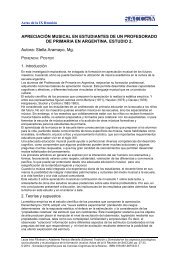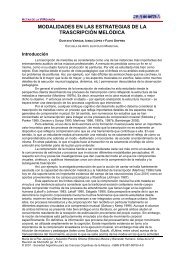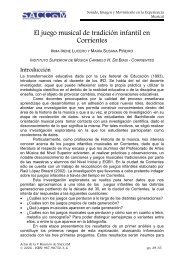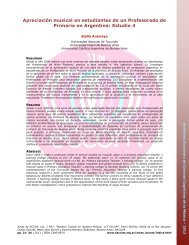NUESTRO CUERPO NUESTRA MÃSICA - Facultad de Bellas Artes
NUESTRO CUERPO NUESTRA MÃSICA - Facultad de Bellas Artes
NUESTRO CUERPO NUESTRA MÃSICA - Facultad de Bellas Artes
Create successful ePaper yourself
Turn your PDF publications into a flip-book with our unique Google optimized e-Paper software.
Cognición Corporeizada y Ejecución Musical I<br />
Method<br />
We collected a small sample of the samba dances using motion-tracking technologies collected<br />
in planned experimental setups. We recor<strong>de</strong>d 30 professional dancers (males and females)<br />
across 2 different samba cultures (Bahia and Belo Horizonte cities) dancing on 2 different tempi.<br />
Dancers were instructed to dance “samba-no-pé” style with no improvisation of embellishembellishments.<br />
It is assumed that professional dancers are able to grasp the instructions and<br />
provi<strong>de</strong> less biased renditions of dance movements. The basic structure of the repetitive gestures<br />
was analyzed using the “Basic gesture” approach (Leman & Naveda, 2010), which<br />
comprises computational and statistical procedures applied to both music and dance data. This<br />
economic <strong>de</strong>scription of the dance gesture subsumes the variability of the gesture of each limb<br />
according the metrical levels of the music and provi<strong>de</strong>s the basic “shape” that supports the<br />
comparison between gestures of the dancers. The analyses applied to the collections of gestures<br />
are displayed as similarity maps that emerge from application of multidimensional scaling<br />
(MDS) techniques to dataset using the metrics provi<strong>de</strong>d by Procrustean distance between<br />
shapes of the gesture. In the sequence, we applied cubic discrimination procedures that inform<br />
how proposed groups (gen<strong>de</strong>r, culture, tempi) are discriminated by the similarity of their gestures.<br />
Results<br />
The results show that the texture of movements displays relevant traces of information that inform<br />
about genre, tempi and style differences, in different <strong>de</strong>grees of significance.<br />
Conclusions<br />
We discuss the performatic displays of genre and culture in dance and music and how the interaction<br />
between music and dance support a broad discussion on the role of the body in the<br />
<strong>de</strong>velopment of musical cultures.<br />
CONCEPTUALIZACIÓN'Y'CORPOREIZACIÓN'DE'LA'MÉTRICA'<br />
MUSICAL'EN'LOS'EJERCICIOS'DE'TÉCNICA'DE'DANZA'<br />
ALEJANDRO GROSSO LAGUNA<br />
Universida<strong>de</strong> <strong>de</strong> Évora<br />
Fundamentación<br />
Los miembros <strong>de</strong> una misma cultura musical comparten una serie <strong>de</strong> intuiciones que les<br />
permiten actuar en la comprensión musical. Se trata <strong>de</strong> conocimientos implícitos que se<br />
reflejan en la habilidad <strong>de</strong>l escucha para superimponer una estructura a los estímulos sonoros<br />
percibidos (Keiler, 1978). Estas intuiciones están organizadas en un conjunto <strong>de</strong> reglas<br />
interiorizadas que le permiten a los individuos <strong>de</strong>ducir estructuras jerárquicas <strong>de</strong> una pieza<br />
musical (Lerdahl y Jackendoff, 1983).<br />
Estudios basados en análisis <strong>de</strong> microgénesis (Siegler y Crowley, 1991; Valsiner, 2007) que<br />
exploraron la naturaleza interactiva <strong>de</strong> la comunicación en clases <strong>de</strong> técnica <strong>de</strong> danza (CTD)<br />
han mostrado que bailarines y músicos <strong>de</strong> danza no suelen tener consciencia <strong>de</strong> que<br />
comparten las mismas intuiciones musicales. En las CTD las características estructurales y<br />
expresivas <strong>de</strong> los movimientos son transmitidos a través <strong>de</strong> una consigna que consiste en una<br />
<strong>de</strong>mostración física y sonora que es organizada para respon<strong>de</strong>r a un marco musicalmente<br />
métrico habitualmente co-construido en vivo por un músico <strong>de</strong> danza. En un estudio previo<br />
mostramos que cuando las consignas presentan información multimodal métricamente<br />
divergente suelen producir estados <strong>de</strong> incomunicación entre los bailarines y el músico. Esto les<br />
produce sensaciones <strong>de</strong> <strong>de</strong>sconcierto <strong>de</strong>bido a que la divergencia “<strong>de</strong>bilita” el acceso a la<br />
intuición musical. Sin embargo cuando las consignas presenten información métricamente<br />
74












